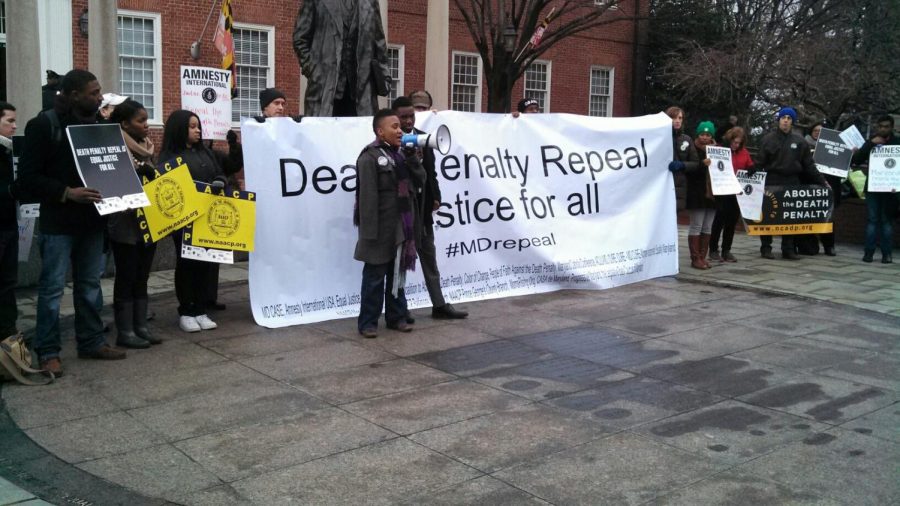Capital Punishment Editorial
Protesters seen here at a rally calling for the end of the death penalty.
Capital punishment has remained a hot button issue in America since the birth of the nation. While some brand this penalty justified retribution, others label it as cruel and unusual punishment that promotes more violence instead of healing. This debate can seem complex and difficult to understand, but an examination of the motives and history of the death penalty provides much-needed clarity.
Capital punishment has a long, complicated history in the United States. While recorded use of capital punishment dates back almost four millennia, the first victim of the death penalty in America (Jamestown, specifically) was suspected spy George Kendall. Following his execution, laws were enacted to make stealing grapes and trading with American Indians punishable by death. The first major movement to abolish these harsh laws was led by Thomas Jefferson, and state laws began to crop up that either relegated capital punishment for use on only the most severe offenses (such as treason or first degree murder), or the death penalty was removed altogether.
Since the eighteenth century, states have fluctuated between outlawing and embracing the death penalty. During the Progressive Era in the early 20th Century, six states removed the death penalty but later reinstated it in response to communist paranoia. It wasn’t until the 1950s and ‘60s that capital punishment was broadly considered “cruel and unusual punishment,” and this debate remains a hotly contested topic in American law.
Many advocates for capital punishment argue that a lesser punishment, such as a life sentence in prison, would be too lenient when compared to the heinous nature of the crime. New York Law School professor Robert Blecker summarizes this argument best when he observes, “How obscene is it that aggravated murderers who behave well inside prison watch movies and play softball.”
Proponents of executions also contend that punishment by death brings closure to the victim’s loved ones. However, opponents of the death penalty argue that the death penalty promotes violence and hatred instead of what is truly needed: healing for survivors. Bringing pain upon another family does not right a wrong, it simply causes more damage.
The cost of capital punishment is a major burden on the state economy, especially in poorer states such as Alabama, where there are 43 criminals on death row per one million citizens. In fact, the median price that the state pays for each death penalty case is $1.26 million, whereas a life sentence costs 48% less. Even more shocking, California’s justice system, which currently requires $137 million per year to function, would only cost $11.5 million if the state abolished the death penalty. It is unfathomable that states use such a large portion of taxes to fund a system that has been proven ineffective at deterring criminals. A whopping 88% of the nation’s most prominent criminologists agree that capital punishment does not have an effect on crime rates. No credible studies have proven that the death penalty decreases criminal activity, making that one of the weakest arguments for its implementation.
Additionally, capital punishment will remain laced with discrimination and injustice as long as the antiquated system endures. Capital case defendants can almost never afford a lawyer, meaning they require the representation of a public attorney. These public defenders often work on 400 felony cases at a time, making it almost inevitable that they will at some point walk into the courtroom utterly unprepared. This will, of course, lead to unfavorable outcomes for their defendants. The death penalty is also unfair in the implicit racism faced by defendants of color; African American defendants are more likely to be sent to death row when compared to white counterparts, according to former Maryland governor Martin O’Malley. Due to racial biases and poor representation, as well as simply being in the “wrong place at the wrong time,” 4.1% of those executed were later proven not guilty using DNA evidence. If these innocent convicts had been given a life sentence rather than the death penalty, they could have been later exonerated when DNA evidence eventually proved the jury wrong. Capital punishment instead acted as a permanent conclusion to an inconclusive verdict.
It can be disquieting to know that the criminal justice system and physicians have the power to take a human life. The death penalty reduces society to the level of a murderer, inundating the country with violence in place of the healing it needs. Capital punishment morphs justice into revenge, leaving cruelty and nonsensical brutality in its wake.
Type One welcomes all opinions and perspectives. If you want to write a letter to the editor, propose an idea, article, or editorial for Type One, please visit our Contact Page to submit a request.
Sources: Death Penalty Info, Dallas News, 24-7 Wall Street, Amnesty USA, OC Register, Washington Post, Newsweek
Photo Source: Wikimedia

Alice Rau is a Pine Crest junior. Alice enjoys rowing, dancing, writing for Type One, and volunteering at a Miami-based Big Buddy program. Alice has spent...
































![Stranger Things 4: What to Expect [Warning: Contains Spoilers]](https://pcpawprint.com/wp-content/uploads/2021/11/StrangerThings4-900x473.jpeg)

























































